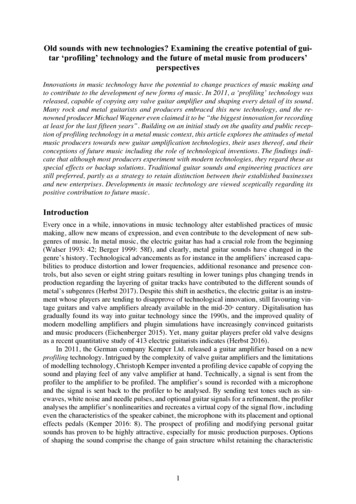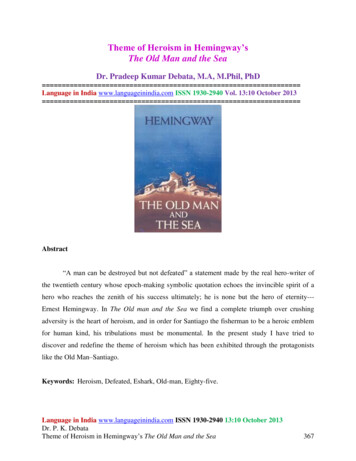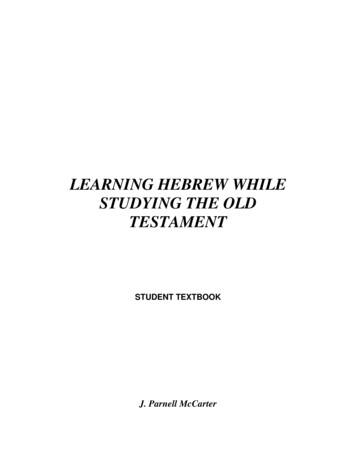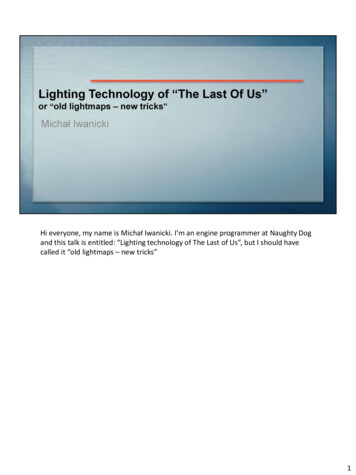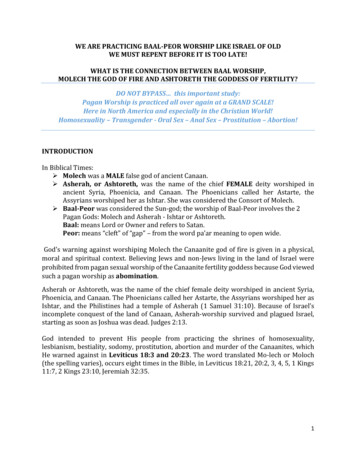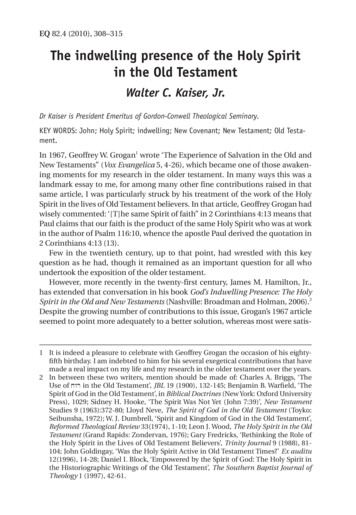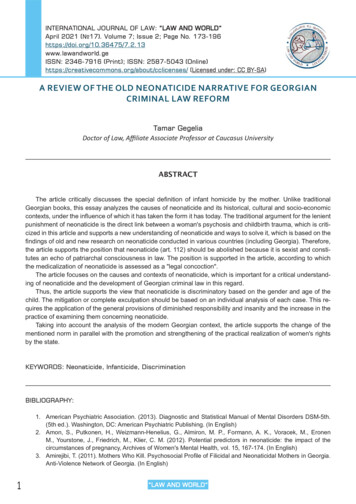
Transcription
INTERNATIONAL JOURNAL OF LAW: “LAW AND WORLD“April 2021 ( 17). Volume 7; Issue 2; Page No. rld.geISSN: 2346-7916 (Print); ISSN: 2587-5043 es/ (Licensed under: CC BY-SA)A REVIEW OF THE OLD NEONATICIDE NARRATIVE FOR GEORGIANCRIMINAL LAW REFORMTamar GegeliaDoctor of Law, Affiliate Associate Professor at Caucasus UniversityABSTRACTThe article critically discusses the special definition of infant homicide by the mother. Unlike traditionalGeorgian books, this essay analyzes the causes of neonaticide and its historical, cultural and socio-economiccontexts, under the influence of which it has taken the form it has today. The traditional argument for the lenientpunishment of neonaticide is the direct link between a woman's psychosis and childbirth trauma, which is criticized in this article and supports a new understanding of neonaticide and ways to solve it, which is based on thefindings of old and new research on neonaticide conducted in various countries (including Georgia). Therefore,the article supports the position that neonaticide (art. 112) should be abolished because it is sexist and constitutes an echo of patriarchal consciousness in law. The position is supported in the article, according to whichthe medicalization of neonaticide is assessed as a "legal concoction".The article focuses on the causes and contexts of neonaticide, which is important for a critical understanding of neonaticide and the development of Georgian criminal law in this regard.Thus, the article supports the view that neonaticide is discriminatory based on the gender and age of thechild. The mitigation or complete exculpation should be based on an individual analysis of each case. This requires the application of the general provisions of diminished responsibility and insanity and the increase in thepractice of examining them concerning neonaticide.Taking into account the analysis of the modern Georgian context, the article supports the change of thementioned norm in parallel with the promotion and strengthening of the practical realization of women's rightsby the state.KEYWORDS: Neonaticide, Infanticide, DiscriminationBIBLIOGRAPHY:1. American Psychiatric Association. (2013). Diagnostic and Statistical Manual of Mental Disorders DSM-5th.(5th ed.). Washington, DC: American Psychiatric Publishing. (In English)2. Amon, S., Putkonen, H., Weizmann-Henelius, G., Almiron, M. P., Formann, A. K., Voracek, M., EronenM., Yourstone, J., Friedrich, M., Klier, C. M. (2012). Potential predictors in neonaticide: the impact of thecircumstances of pregnancy, Archives of Women's Mental Health, vol. 15, 167-174. (In English)3. Amirejibi, T. (2011). Mothers Who Kill. Psychosocial Profile of Filicidal and Neonaticidal Mothers in Georgia.Anti-Violence Network of Georgia. (In English)1“LAW AND WORLD“
4. Anand, S. (2010). Rationalizing infanticide: medico-legal assessment of the criminal code's child homicideoffence. Alberta Law Review, 47(3), 705-728. (In English)5. Ashworth, A. 2011. United Kingdom, in Heller, K. J. & Dubber, D. M. (eds), Handbook of comparative criminallaw, Stanford: Stanford University Press. (In English)6. Ashworth, A., & Horder, J. (2013). Principles of Criminal Law. (7th edition). Oxford: Oxford University Press.(In English)7. Ayres, S. (2007). Who is to shame narratives of neonaticide. William & Mary Journal of Women and the Law,14(1), 55-106. (In English)8. Beyer, K., Mack, S. & Shelton, J. (2008). Investigative analysis of neonaticide: An exploratory study. CriminalJustice and Behavior, 35(4), 522-535. (In English)9. Brennan, K. (2013). Traditions of English Liberal Thought: History of the Enactment of an Infanticide Law inIreland. Irish Jurist, 50, 100-137. (In English)10. Brennan, K. (2018). Murderous mothers & gentle judges: Paternalism, patriarchy, and infanticide. Yale Journalof Law and Feminism, 30(1), 139-196. (In English)11. Brennan, K. (2018). Social norms and the law in responding to infanticide. Legal Studies. The Journal of theSociety of Legal Scholars., 38(3), 480-499. (In English)12. Committee on the Rights of Persons with Disabilities, General comment No. 1 (2014). (In English)13. Chandra, P. S., Herrman, J.F., Riecher-Rössler, A. (eds), Mental Health and Illness of Women. (2020).Geneva, Switzerland: Springer. (In English)14. Dvorak, J. J. (1998). Neonaticide: Less than murder. Northern Illinois University Law Review, 19(1), 173-196.(In English)15. Fazio C. A.& Comito, J. L. (1999). Rethinking the Tough Sentencing of Teenage Neonaticide Offenders in theUnited States, Fordham Law Review, vol. 67, 3109 – 3168. (In English)16. Friedman, S., Cavney, J., & Resnick, P. J. (2012). Mothers who kill: Evolutionary underpinnings and infanticidelaw. Behavioral Sciences & the Law, 30(5), 585-597. (In English)17. Gamkrelidze, O. (2000). Intentional Neonaticide by a mother. In Gamkrelidze, O. (ed.) Commentary onCriminal Court Practice, Offences Against Person, Tbilisi: The Institution of Law and State of GeorgianAcademy of Science. (In Georgian)18. Gamkrelidze, O. (2008), Commentary of Criminal Code. (2nd ed.). Tbilisi. (In Georgian)19. Herring, J. (2018). Criminal Law: Text, Cases, and Materials. (8th edition). Oxford: Oxford University Press.(In English)20. Hogan, M. C. (1999). Neonaticide and the misuse of the insanity defense. William & Mary Journal of Womenand the Law, 6(1), 259-296. (In English)21. Holland, W.H. (2007). Infanticide. In Horder J. (ed) Homocide Law in Comparative Perspective, Oxford andPortland, Oregon: Hart Publishing. (In English)22. Jishkariani B. (2016). Special Part of Criminal Law, Offence Against Person, Tbilisi: World of Lawyers. (InGeorgian)23. Johnson, K.K. & Watson, W. D. (2006). The Insanities of Reproduction: Medico-legal Knowledge and theDevelopment of Infanticide Law, Social & Legal Studies, vol. 15(2), 237–255. (In English)24. Kaplan, D. S. (2014). Who are the mothers who need safe haven laws: An empirical investigation of motherswho kill, abandon, or safely surrender their newborns. Wisconsin Journal of Law, Gender and Society, 29(3),447-512. (In English)25. Krüger, P. (2015). Prevalence and Phenomenology of Neonaticide in Switzerland 1980–2010: A RetrospectiveStudy, Violence and Victims, vol. 30, 194-207. (In English)26. Kyd, S., Elliott, T., & Walters, M. A. (2017). Clarkson & Keating: Criminal Law: Text and Materials. (9th edition).London: Sweet & Maxwell. (In English)27. Klier, CM, Grylli, C, Amon, S, Fiala, C, Weizmann-Henelius, G, Pruitt, SL, & Putkonen, H. (2013). Is theintroduction of anonymous delivery associated with a reduction of high neonaticide rates in Austria? Aretrospective study. BJOG. An International Journal of Obstetrics and Gynaecology, vol. 120 (8), 1028-1029.(In English)28. Klier, C. M., Amon, S., Putkonen, H., Fernandez Arias, P., & Weizmann-Henelius, G. (2019). Repeatedneonaticide: differences and similarities to single neonaticide events, Archives of Women's Mental Health,vol. 22, 159-164. (In English)29. Lekveishvili M., Todua N., & Mamulashvili G., (2019). Special Part of Criminal Law, Book I. 7th Ed.). Tbilisi:Meridiani. (In Georgian)30. Loughnan, A. (2012). The 'Strange' Case of the Infanticide Doctrine. Oxford Journal of Legal Studies, vol. 32(4), 685-711. (In English)31. Macfarlane, J. E. (1998). Neonaticide and the Ethos of Maternity: Traditional Criminal Law Defenses and the“LAW AND WORLD“2
Novel Syndrome. Cardozo Women's Law Journal, 5, 175-248. (In English)32. Mair, S. (2018). Challenging infanticide: Why section 233 of Canada's criminal code is unconstitutionalManitoba Law Journal, 41(3), 241-280. (In English)33. Marks, M. M., & Kumar, R. R. (1993). Infanticide in England and Wales. Medicine, Science and the Law,33(4), 329-339. (In English)34. Markwalder N. & Killias, M. (2012). Homicide in Switzerland, Liem, M.C.A. & Pridemore, W.A. (eds.), Handbookof European Homicide Research: Patterns, Explanations, and Country Studies, New York: Springer-Verlag.(In English)35. Martinkienė, V., Dembinskas, A., & Germanavičius, A. (2015). Analysis of the 1994-2014 data of ExpertStudies on Women Who Committed Neonaticide Conducted by the National Service of Forensic Psychiatryin Lithuania under the Ministry of Health, Health science in Eastern Europe, vol. 25(5), 1-10. (In English)36. Martinkiene, V., & Dervinyte – Bongarzoni, A. (2015). Is Psychiatric Illness Leading Reason of Neonaticide inLithuania? European Psychiatry, 30(S1), 1-1. (In English)37. Mesut, I. (2018). Postpartum Psychosis. Eastern Journal of Medicine, vol. 23(1), 60-6338. Neil, V., & Hans, V. (2019). American Juries: The Verdict, Tbilisi: Ilia state University Press. (In Georgian)39. Ormerod, D., & Laird, K. (2018). Smith, Hogan and Ormerod‘s Criminal Law: Cases and Materials. (15thedition). Oxford: Oxford University Press. (In English)40. Porter, T. & Gavin, H. (2010). Infanticide and Neonaticide: A Review of 40 Years of Research Literature onIncidence and Causes, Trauma, Violence, & Abuse, vol. 11(3) 99-112. (In English)41. Resnick, P. (1970). Murder of the Newborn: A Psychiatric Review of Neonaticide. American Journal ofPsychiatry, vol. 126(10), 1414-1420. (In English)42. Richter, J. S. (1998). Infanticide, Child Abandonment, and Abortion in Imperial Germany. The Journal ofInterdisciplinary History, vol. 28(4), 511-551. (In English)43. Sclater, S. D. (2011). Infanticide and Insanity in 19th Century England, In Herring, J., Richards, M., & EbtehajF. (eds). Birth Rites and Rights, Oxford, Portland, Oregon: Hart Publishing, 2011. (In English)44. Slate, A. (2019-2020). Infanticide Act: Anachronistic Perpetuation of Chivalric Justice, Gender-Stereotypingand Inequitable Treatment of Men in England. Journal of Global Rights and Organizations, vol. 10, 187-224.(In English)45. Spain, J. (2013). Changing the narrative of neonaticide. Indiana Journal of Law and Social Equality, 2(1),[viii]-181.46. Special Report of the Public Defender. (2017). Human Rights in Terms of Sexual and Reproductive Healthand Well-Being: An Assessment of the Legal Status of the Country. (In Georgian)47. Spinelli, M.G. (2000). Infanticide, Psychosocial and Legal Perspective on Mothers Who Kill. (1st ed.).American Psychiatric Publishing Inc. (In English)48. Stasiūnienė, J., Justickis, V., & Jasiulaitis, A. (2015). Newborn murder and its legal prevention. Health Policyand Management, 1(8), 91–119; (In English)49. Tanaka, C. T., Berger, W., Valença, A. M., Coutinho, E. S. F., & others. (2017). The worldwide incidence ofneonaticide: a systematic review, Archives of Women's Mental Health, vol. 20, 249 – 256. (In English)50. The Public Defender (Ombudsman) of Georgia. (2019). Sexual and Reproductive Health and Human Rights:National Assessment. (In Georgian)51. Turava, M. (2011). Doctrine of Crime. Tbilisi: Meridiani. (In Georgian)52. Vallillee, E. (2015). Deconstructing infanticide. Western Journal of Legal Studies, 5(4), 1-11. (In English)53. Walker, A. J. (2006). Application of the insanity defense to postpartum disorder-driven infanticide in the unitedstates: look toward the enactment of an infanticide act. University of Maryland Law Journal of Race, Religion,Gender and Class, 6(1), 197-222. (In English)54. Willenbacher, B. (2004). Legal Transfer of French Traditions? German and Austrian Initiatives to IntroduceAnonymous Birth. International Journal of Law, Policy and the Family, vol. 18, 343-354. (In English)55. Wu, M. W. C. (2003). Culture is no Defense for Infanticide. American University Journal of Gender SocialPolicy and Law, vol 11(2), 975-1021. (In English)56. Zaretsky, R. S. (2012). Parents who kill their babies: Why the discrepancy and leniency in sentencing is notjustified. Criminal Law Quarterly, 59(Issues 2 & 3), 416-ii. (In English)57. Zedner, L. (1991). Women, Crime, and Penal Responses: A Historical Account. Crime and Justice, Vol. 14,307-362. (In English)NOTES:1. The article examines the historical study of the issue insofar as it is accompanied by a recollection of existingstereotypes about women it is necessary to clarify that the article does not share the opinion that people with3“LAW AND WORLD“
ho-social needs are not equal to other people who do not have disabilities. The author shares the viewthat the medicalization of disability is contrary to the modern approach based on the rights of persons withdisabilities. See UN Convention on the Rights of Persons with Disabilities, Art. 1 & Committee on the Rightsof Persons with Disabilities, General comment No. 1 (2014) on Article 12: Equal recognition before the law.(In English)Neonaticide is also called the "partial defense" of the biological mother. See Loughnan, A. (2012). The'Strange' Case of the Infanticide Doctrine. Oxford Journal of Legal Studies, vol. 32 (4), 686. (In English)Resnick, P. (1970). Murder of the Newborn: A Psychiatric Review of Neonaticide. American Journal ofPsychiatry, vol. 126(10), 1414; Stasiūnienė, J., Justickis, V., & Jasiulaitis, A. (2015). Newborn murder and itslegal prevention. Health Policy and Management, 1(8), 93; Spinelli, M.G. (2000). Infanticide, Psychosocialand Legal Perspective on Mothers Who Kill. (1st ed.). American Psychiatric Publishing Inc., (Chapter 1),12; Friedman, S., Cavney, J., & Resnick, P. J. (2012). Mothers who kill: Evolutionary underpinnings andinfanticide law. Behavioral Sciences & the Law, 30(5), 593. (In English)Spinelli, M.G., Supra note 3, (Chapter 10),186; Dvorak, J. J. (1998). Neonaticide: Less than murder. NorthernIllinois University Law Review, 19(1), 173; Hogan, M. C. (1999). Neonaticide and the misuse of the insanitydefense. William & Mary Journal of Women and the Law, 6(1), 260; Kaplan, D. S. (2014). Who are the motherswho need safe haven laws: An empirical investigation of mothers who kill, abandon, or safely surrender theirnewborns. Wisconsin Journal of Law, Gender and Soci
CRIMINAL LAW REFORM Tamar Gegelia Doctor of Law, Affi liate Associate Professor at Caucasus University ABSTRACT The article critically discusses the special defi nition of infant homicide by the mother. Unlike traditional Georgian books, this essay analyzes the causes of neonaticide and its historical, cultural and socio-economic contexts, under the in fl uence of which it has taken the form .

